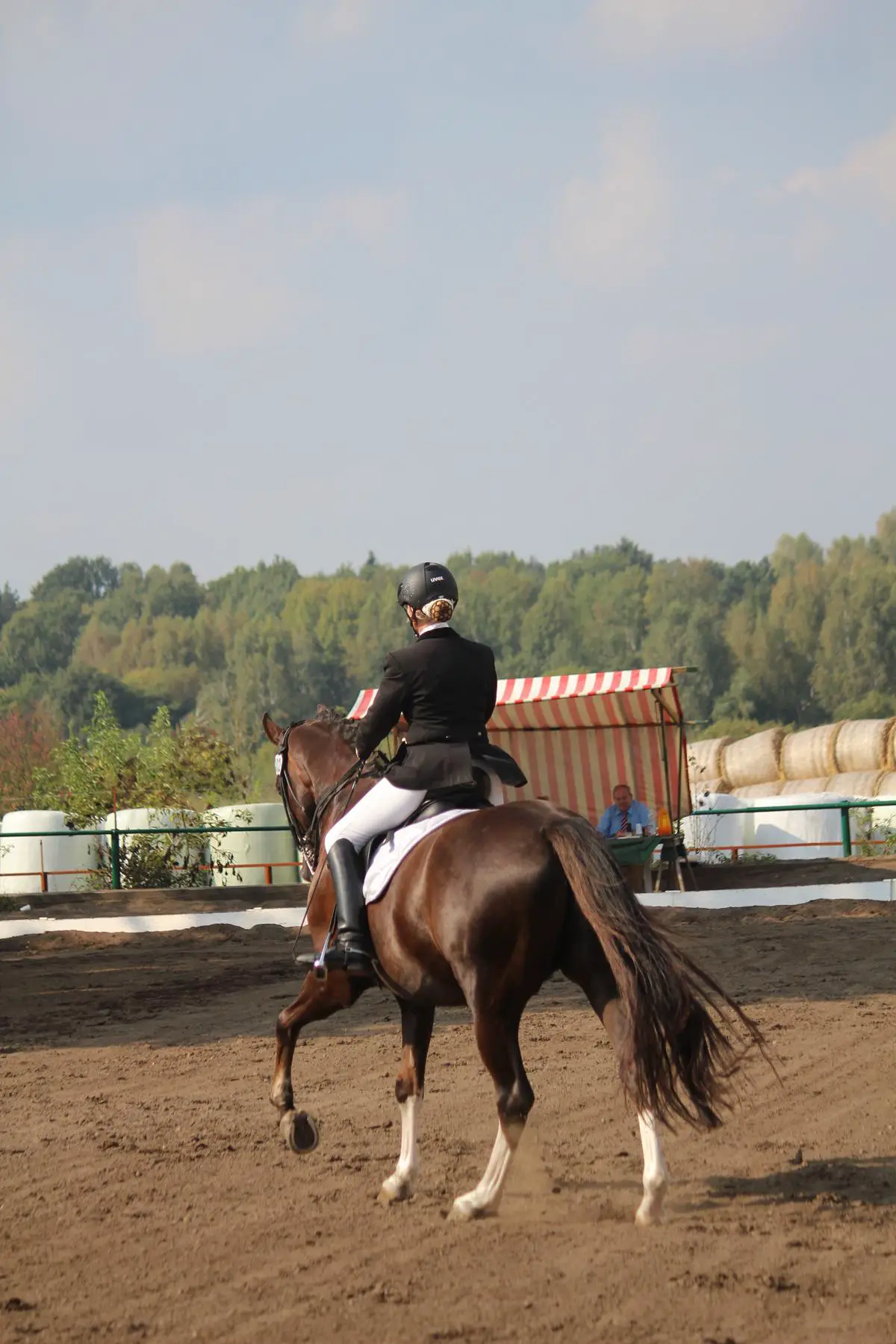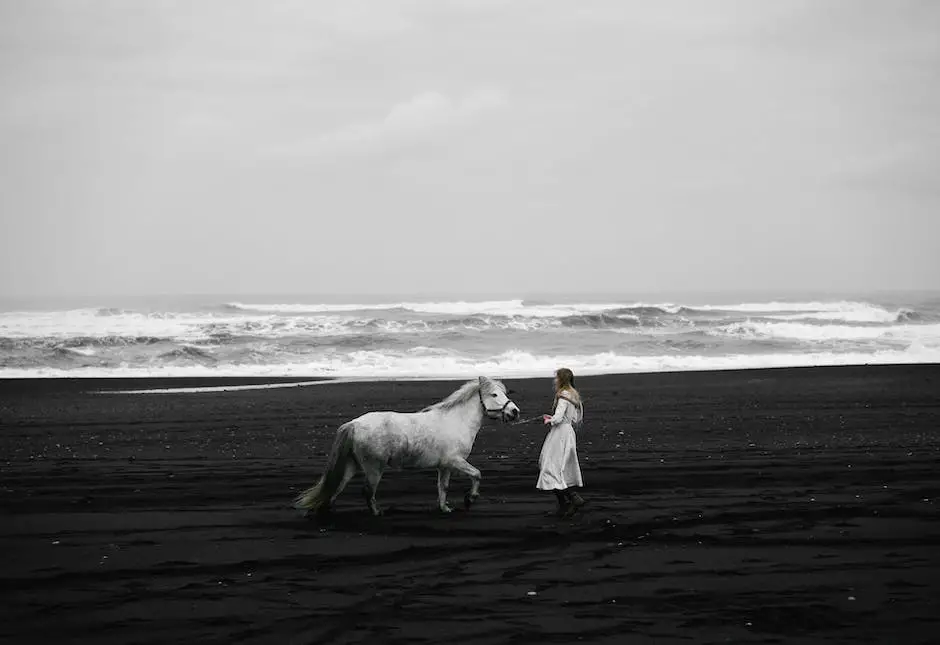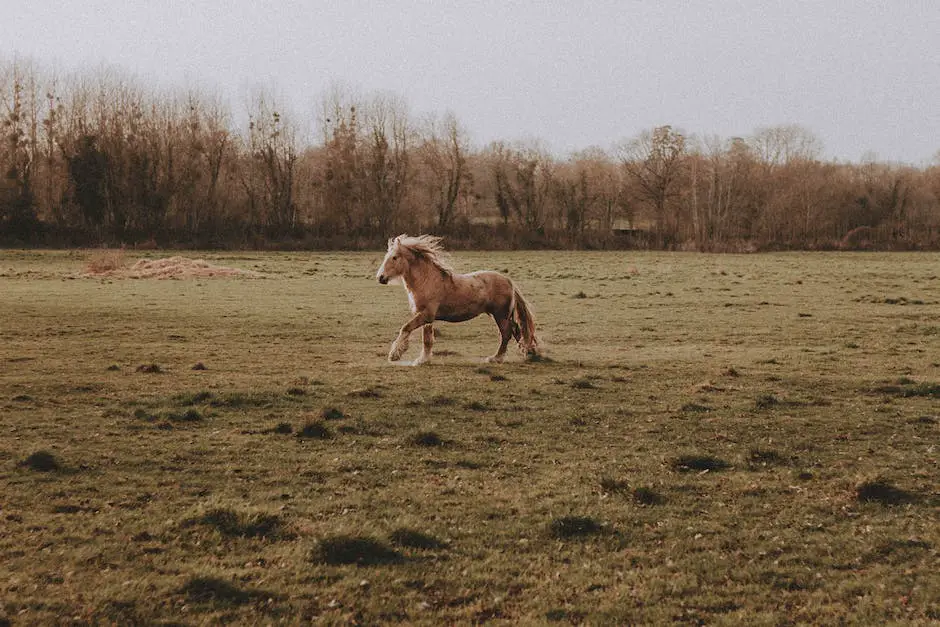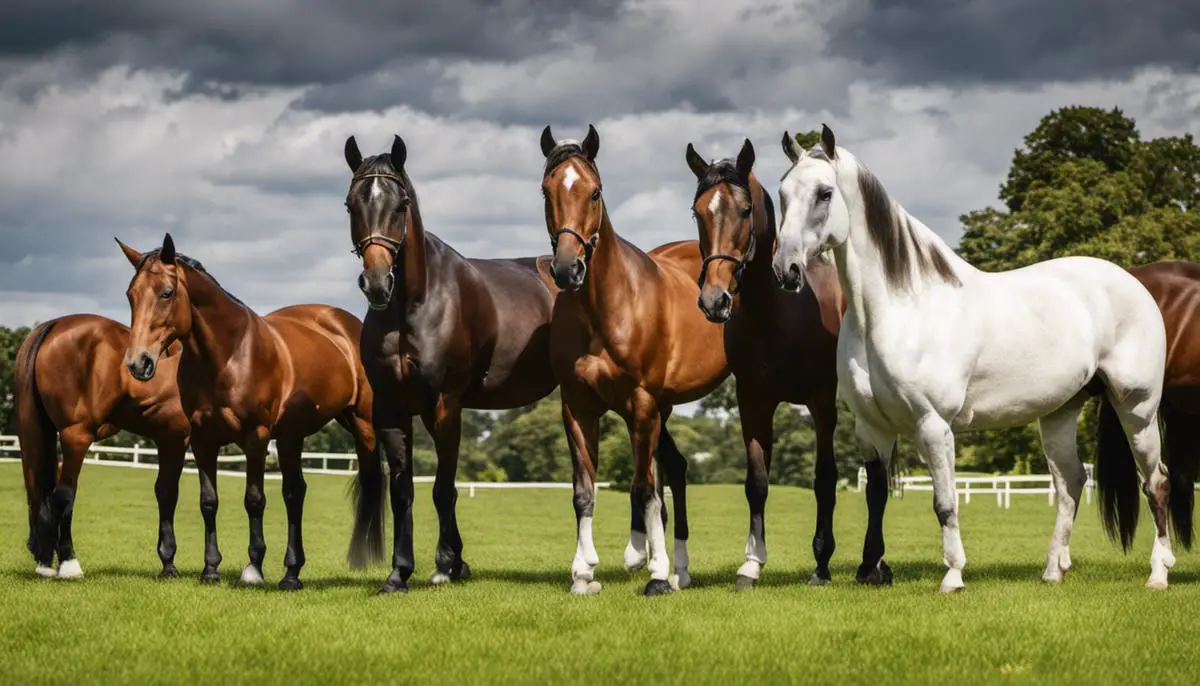The enchanting world of warmblood horse breeds is a realm filled with strength, grace, and a noble lineage that is unique to the equestrian universe. These breeds, celebrated for their distinctive characteristics and illustrious history, compels enthusiasts to delve deeper into their vivid tapestry. Appreciating and understanding warmblood horse breeds requires an exploration of their physiological traits, temperaments, and common usage, alongside knowledge about the top European and American variations. Moreover, awareness of their care, maintenance and the complexities of buying and breeding these horses offers an enriched perspective. This deep-dive provides a guide to navigate each aspect thoroughly, unraveling the fascinating details that make warmblood horses intriguing and highly prized among horse lovers.
Table of Contents (Horspedia)
Understanding the Warmblood Horse Breeds
The Distinct Peculiarities: Warmblood breeds versus other Equestrian Contenders
Every equestrian aficionado knows that horse breeds are not created equal. As any seasoned equestrian hobbyist can attest, the differences go far beyond the outward appearances. A profound case in point? The uniquely charming Warmblood breeds. Whether these graceful creatures are leaping over fences in a showjumping ring, dancing across a dressage arena, or merely grazing in a pasture, their distinct qualities are undeniably captivatingly different from other horse breeds.
Warmbloods: Elegant Athletes or Gentle Giants? Both.
Characteristically, Warmblood horses are the amalgamation of the agility seen in lighter, “hot-blooded” breeds like Thoroughbreds, and the quiet temperament exhibited by heavier, “cold-blooded” types like draft horses. They’re the sophisticated hybrids of the equestrian world. With their incredible size and power—usually standing between 15.2 and 17.2 hands—merged with a remarkably calm and cooperative nature, they’ve earned both their athletic acclaim and their status as gentle giants.
It’s all in the Breeding
Unlike other horse breeds, Warmbloods are not defined by their pedigree but by their purpose as a sport horse. This means their breed designation isn’t determined by their genealogy, but their aptitude to excel in specific athletic disciplines. Such a breeding scheme, referral to performance testings, has shaped these horses to be versatile and multifaceted rivals in various equestrian sports, predominantly in dressage and showjumping.
Warmbloods Worldwide
Essentially, Warmbloods originate from different regions in Europe, from where their names are attributed: Hanoverians from Hannover, Germany; Dutch Warmbloods from the Netherlands; Belgian Warmbloods from Belgium, and so forth. Even though they share the “Warmblood” moniker, each of these breeds showcases their unique characteristics influenced by their geographical origins.
The “Open Studbook” Distinction
Unlike “closed studbook” breeds such as Thoroughbreds or Arabians, where a horse’s parents must both be of the same breed to qualify, Warmblood registries employ an “open studbook” policy. This allows crossbreeding with horses from other Warmblood registries or approved “hot-blooded” breeds, providing they meet the strict performance and conformation standards. This unique, selective breeding practice ensures the enhancement of their physical characteristics and performance abilities, setting them apart from their equestrian counterparts.
To wrap things up, if there’s one thing this dive into Warmblood breeds signifies, it’s that nothing about them is accidental. Right from their temperament, athletic prowess, performance-based breeding policies, global diversity, to their open studbook practices—everything echoes intentional crafting for excellence. As any Warmblood enthusiast would agree, these magnificent equines are truly in a league of their own in the lovely, vast canvas that is the horse world. Let this brief exploration intrigue any equestrian hobbyist into knowing more, into appreciating more about these stunning Warmblood breeds. After all, there’s always more to learn in the enriching world of equestrian pursuits.
Foremost, whether it’s the Warmblood breeds or their equestrian counterparts, it’s important to remember that at the end of the day, they’re all wonderful creatures, each with their own distinct charm and virtue. In love with equines? Well, it doesn’t matter which they are—hot blood, cold blood, or warm blood—the love for horses knows no bounds!

Top European Warmblood Horse Breeds
The undeniable charisma of European Warmbloods, with their powerful legs, agile bodies, and compelling performances, continues to cast a spell on the equestrian world. These equine masterpieces have certainly earned their reputation, and what sets them apart is worth our attention. They have a history steeped in careful selection and breeding, a journey whose beautiful result is a fusion of power, agility, speed, and a level-headed demeanor.
One pivotal aspect of European Warmblood glory is epitomized in dressage. This refined form of equestrian ballet showcases the breathtaking capabilities of these breeds. Warmbloods are unmatched in their ability to excel in high-level dressage, moving with a graceful, captivating tempo that many horse enthusiasts could never dream of seeing in other breeds. Their unique blend of strength, flexibility, and rhythm is simply a sight to behold.
The next salient component in the Warmblood success story is how these horses adapt in the jumping arena. Whether at a local show or the Olympics, European Warmbloods consistently outshine the competition. Their astounding power, fostered by meticulous breeding programs, combined with their intelligent and willing temperament, allows them to clear challenging obstacles with a composure and deftness that is unmatched.
Perhaps, the most exceptional trait Warmbloods are praised for is their temperament. Despite their power and dynamic mobility, they are recognized for their calm, stable, and trainability. Their demeanor, a far cry from the “hot-blooded” temperament, is equally suitable for professional equestrians and amateur riders alike. This versatile adaptability, to offer peak performance to professionals, yet gentle reliability to novices, furthers the esteem of Warmbloods in the equestrian world.
Moving on, there is no discussion about Warmbloods that doesn’t involve their breeding techniques. A celebrated feature of their studbooks is the Pre-Selection Testing, where each stallion and mare must prove their worthiness. This rigorous appraisal system, based not just on its pedigree but significantly on its performance, physique, and health, ensure only the best genes propagate.
Lastly, European Warmbloods are examples of the commitment to sustainable development practices in breeding. Organized in breed registries, each with its own stringent selection process, they promote responsible breeding to ensure quality over quantity, championing improved genetic diversity over time, and reducing the risk of genetic diseases.
In closing, the prominence of European Warmbloods in the equestrian world is no coincidence. Their excellence results from careful breeding, unrivaled performance, and remarkable temperament. Truly, they are a testament to the power of commitment to quality, shedding light on the passion and dedication invested in this magnificent breed. Each stride they take, each fence they jump, each dressage movement they perform is a celebration of the brilliance that resonates throughout the equestrian world. This is the phenomenon of the European Warmblood.

American Warmblood Horse Breeds
Diving into the distinctly American sphere of Warmblood breeding, among the most notable breeds stands the American Warmblood. These horses are renowned for their versatility. Unlike their European counterparts, the breeding of American Warmbloods isn’t limited to specific bloodlines, giving room for a variety of breeds, including Thoroughbred, Arabian, or Morgan, to influence the final product.
However, the American Warmblood isn’t a cut-and-dry breed; it’s a registered product of purposeful and strategic breeding aiming for a well-rounded sport horse. The ambition is to breed a horse capable of excelling in dressage, jumping, eventing, and even driving. It makes them the Swiss-army-knife of the equestrian world, where versatility is adored.
Of course, one cannot overlook the American Warmblood Society’s (AWS) and the American Warmblood Registry’s (AWR) pivotal role in maintaining the breed’s objective. Both organizations have stringent inspection processes, ensuring the breed’s quality and perpetuity align with established standards.
Juxtaposing with the Europeans, the Warmbloods originated there have a treasure trove of distinct breeds, each linked to its specific homeland. They carry names that ring like a geography lesson; Holsteiner, named after the Holstein region in Germany, Hanoverians from the Hanover region, and the Dutch Warmblood, hailing from the Netherlands, to name a few. These horses are highly specialized, often marking their fame in specific equestrian disciplines due to meticulous, centuries-old breeding practices.
One of the most unique processes European Warmblood breeders embrace is Pre-Selection Testing or “Keuring.” Horses go through a rigorous testing process to determine if they are breeding material, setting the bar high in terms of quality and capability.
However, the heart of the difference between our valiant American Warmbloods and their European siblings lies within the philosophy of breeding. With a strong emphasis on performance rather than bloodlines, American Warmblood breeding programs focus on the output’s equestrian capabilities. On the other hand, European breeders have often centered their efforts around maintaining pure, regional centric pedigrees, leading to high specialization.
It’s an exciting time for the American Warmblood breed. As breeders on this side of the pond continuously evolve their practices, the beat of hooves in the dressage ring, the measured pace during a jumping event, the strength, and grace in eventing, all speak of the passion and dedication that is poured into this breed.
Different, yet equally impressive, European and American Warmbloods make horse-loving hearts race, each bringing their own appeal and charm into the equestrian world. Both have their prestigious place, with their loyal followers, one hailing versatility, the other embracing hundreds of years of meticulous selection processes and tradition. This contrast indeed enriches the wonderful world of horses, making the equestrian landscape a vibrant and continuously diversifying field.

Care and Maintenance for Warmblood Horses
Confidently, one can proclaim that we’ve deeply plunged into the world of Warmblood horses, exploring their background, understanding their uniqueness, and we’ve unveiled their charisma in the equestrian sphere.
Now, how can we optimize our care for these majestic animals, striving for top health and performance?
Foremost, dietary surveillance is paramount. Providing a high-quality diet, rich in fiber and protein, will ensure the health and strength of your Warmblood. Incorporating ample high-grade hay, vitamins, and minerals into their diets will keep their digestive system regulated while nourishing their bones and muscles. Remembering that each animal is unique, so the diet should be tailored to their specific needs, considering factors such as age, weight and activity levels.
Access to clean water, both in the stall and the pasture, is vital. Equally important is providing a salt block in the horse’s dwelling. This will keep them hydrated and ensure they replenish those vital minerals sweated out during rigorous routines.
Moving on to physical conditioning, it’s pivotal to schedule regular exercises that consist of a balance between intense training, light activities, and rest. Warmbloods are naturally athletic, securing that their agility, speed, and stamina are well-maintained is an obligation. Still, it’s also important to realize every horse is unique – their training regime should align with their individual capabilities and preferences.
Routine veterinary check-ups and constant monitoring of your Warmblood’s overall condition are elemental in their health care. Regular vaccinations and de-worming, as well as checking their teeth, should be part of the healthcare routine. Don’t overlook even minor signs of discomfort – early detection of potential health issues will provide a greater possibility for successful treatment.
Equine hooves should never be ignored, it’s said that a sound horse is built from the ground up. Regular farrier appointments are essential to maintain the hoof health. Whether you choose to shoe or keep your Warmblood barefoot depends on the individual horse, its tasks, and terrain it works on.
Bonding with your Warmblood plays a significant part in its mental wellbeing, which directly influences its physical health and performance. Horses are sentient beings that appreciate being groomed and loved. A bonding time will help them develop trust in their handler, reducing their stress levels, and contributing to their overall happiness.
Lastly, housekeeping is another aspect that can’t be overemphasized. Maintaining a clean environment for your Warmblood, whether stall or pasture, prevents diseases and promotes a harmonious ambiance. Regular removal of manure, providing adequate ventilation, and clean, dry bedding are simple steps to follow that result in better health and comfort for the horse.
Ultimately, caring for Warmbloods is an adventurous journey resting on the pillars of loving earnest care, conscious observance, and an unswerving commitment. Hold steadfast to these principles, and you’re set on the rewarding path to seeing your Warmblood thrive in its health and performance. Let’s champion the excellence and commitment inherent in the world of these magnificent Warmbloods.

Buying and Breeding Warmblood Horses
If you’re planning on taking the exciting plunge into the world of Warmblood ownership, it’s absolutely crucial to perform a comprehensive assessment of the horse’s overall health and physical condition before making a purchase. Keep in mind, a horse’s health screening is inherently more extensive and complex than that of smaller animals due to their size and expected lifespan. Engaging a trusted equine veterinarian’s help will provide you with a thorough understanding of the horse’s health history and soundness evaluation.
Equally pivotal is the potential sire and dam’s health and performance history. Evaluate the parents’ performed disciplines and identify any genetic diseases that might be prevalent in their lines. The genetic profile of a Warmblood horse significantly influences its versatility and performance in various equestrian sports.
While selecting your Warmblood, the conformation of the horse should be a primary factor in your considerations. Every feature, from the shape of their hooves and legs to their muzzle and back, can impact the horse’s movement and athleticism. An ideal Warmblood should possess a proportionate and balanced build, which translates to a smooth, powerful, elegant and agile movement.
A lesser known, but equally significant, aspect to be considered when buying and breeding Warmbloods, is the horse’s temperament. Though Warmbloods are recognized for their even-tempered demeanor, it’s essential to remember that individual temperaments may vary. Therefore, consider spending time with the horse before proceeding with the purchase to gauge its personality, behavior, and responsiveness.
Analyzing the talent and training of a Warmblood horse is essential, especially if your intention is to participate in equestrian sports. A high-quality Warmblood should typically display aptitude for learning, acute responsiveness to training, and a degree of natural talent for either dressage or jumping sports.
In addition to this, the cost associated with owning and maintaining a horse should not be overlooked. Remember, the cost of buying a Warmblood is only a fraction of the entire amount that you will be spending over the years. From the cost of feed, horse supplies and care products, to veterinary expenses, the costs can quickly add up. Factor in these expenses, possible training costs, and potential event or competition fees if equestrian sports are in the picture.
It goes without saying, investing in a Warmblood is not a light, spur-of-the-moment decision. It involves careful planning, comprehensive research, adequate resources, and a substantial commitment of time and effort from your end. However, the relationship between a rider and their Warmblood horse is one of incredibly rewarding partnership and camaraderie. So, when you embark on this exhilarating journey of Warmblood ownership, with careful consideration and preparation, you are rewarded with an equine companion that’s truly gallops beyond all expectations.

Warmblood horses capture the heart of all who come across them, owing to their charm, agility, and illustrious lineage. Recognizing the crucial aspects including their unique characteristics, the European and American variations, and their role in equestrian sports, deepens our appreciation of these breeds. Additionally, gaining insights on their care, nutrition, and exercise regimes helps in maintaining their prime health. The journey of discovering, buying, and breeding these horses can indeed be intricate, but with comprehensive understanding it becomes a rewarding quest. Every encounter with a warmblood horse is an opportunity to admire the rich tapestry of their breed, further solidifying our admiration and love for these magnificent creatures.

